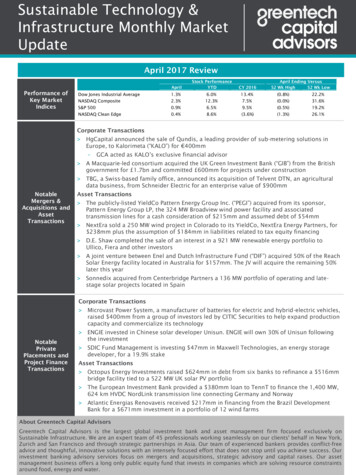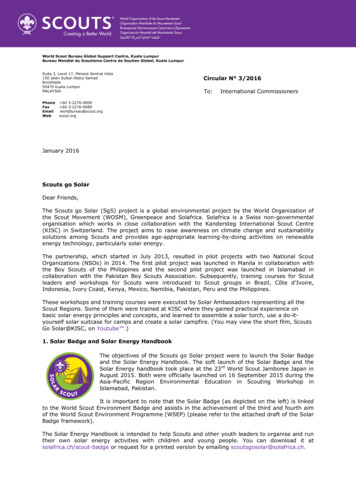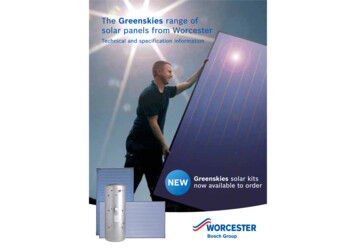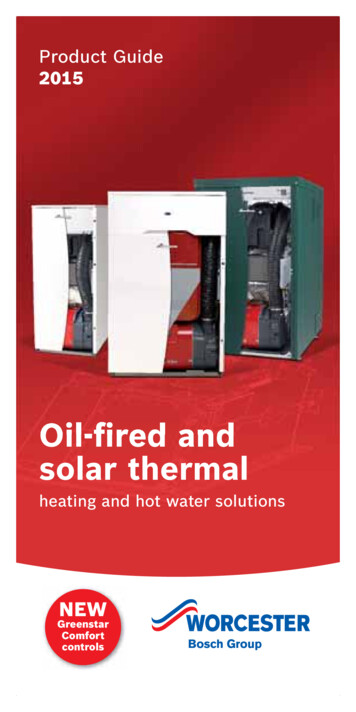
Transcription
Installation manualPV SolarMODULEPlease read this manual carefully before operatingyour set and retain it for future referenceN-TYPE MODELSLGXXXQ1C(K)-A5P/NO : MFL69724902 (Rev 00)www.lg-solar.com
Table of ContentsCONTENTS1. Safety32. Before & After Installation43. Electrical Installation54. Mechanical Installation65. Product Specifications86. Disclaimer of Liability / Disposal107. Transporting and Storage108. Appendix.11Revisions TableDateVersion2016.09.021.0 (1st edition)2016.12.072.0Description of changeRemarkAdd New Products(Black Model)2
SafetyThe instructions related to the safety indicated inthe following are for preventing unexpected dangeror damage in advance by safely and exactly usingthe product.Non-compliance of the instructions may immediately cause serious injury or death.Non-compliance of the instructions may causedeath or serious injury to the user.Non-compliance of the instructions may causeinjury or property damage to the user.①Do not contact with electrically active parts ofthe panel, such as terminals, regardless ofconnection of the module. It may result in sparkor lethal electric shock.②Please don’t use the module with the brokenwindow or the torn back side. There is a dangerof electric shock.①②①Please perform works in the dry condition anduse only dry tools. Do not handle the wet panelswithout protection equipment. It may result insafety accident.②Damaged module must be treated with safetyprotection equipment. It may result in injury.③Do not approach the damaged or broken moduleunless you are an expert. It may result in seriousinjury.④No electrical parts like cables are located afterinstallation between laminate and mountingstructure.⑤Do Not reconnect or repair Junction box Cable.It may occur spark or electric shock.⑥ Do not bending junction box's cable. Whileunder stress, it may occur module damage.Cable bending radius should be more than4 times the cable diameter, at least.①Please use proper equipment, connector, wireand buttress for system configuration of themodule. It may result in damage or failure of theproduct.②Do not perform installation in rainy, heavilywindy or snowy days. It may result in safetyaccident.③Do not make holes in the frame or glass of themodule. It may decrease the strength of theframe or break the glass.④Do not touch the glass surface or frame of thesolar module after installation of the module. Itmay result in injury.⑤Do not locate a heavy object onto the module.Do not stand on or step on the module. Do notdrop or suddenly lay down the module. It mayresult in injury.⑥Do not scratch the coating surface of the frame.It may decrease the strength due to corrosion ofthe frame.⑦Do not concentrate sunlight on the modulesurface. It may result in damage of the product.⑧Do not apply a shock to the junction box of themodule or pull the cable. Do not remove thelabels attached to the module. It may result indamage of the product.⑨If the installing structure has a curved surfacee.g. arch type as shown in the below picture, donot forcefully modify the module in installationwhen connecting it with the structure. Pleaseinstall the module in the place where the structurehas been completely set up because deformationof the structure may cause deformation of theproduct when performing installation by using acrane, etc after assembling the module to theinstalling ��3
Before & After InstallationBefore InstallationPlease carefully read this manual beforeinstallation. Solar module installation should be performed byan authorized installer for the safety andmaintenance of the system. All installation instructions should be clearlyunderstood before attempting installation. Do not twist, pull, or scratch the cable attached tothe solar module. Do not touch the solar module with bare hands. Itmay result in a burn or injury. Do not drop the solar module and cause anexcessive load on solar module. Do not disassemble the solar module. After installation or repair, check whether solarmodule operates properly or not. In case the currently used solar module or theparts applied to the solar module have beenreplaced, check whether the changed solarmodule is properly operated or not. The newlyreplaced solar module and its parts must be thesame solar module(module name) and parts withthe current solar module. Please contact the local office to confirm theregulations and to obtain permission. Do not let anyone approach the solar modulewho has little knowledge of solar modules or onthe measures to take when solar modules aredamaged in order to avoid the risk of injury orelectrical shock. Do not locate the solar module horizontally, asthis may cause dirt or white efflorescence (glassdeformation) Panels produce voltage even when notconnected to an electrical circuit or load. Panels are intended for outdoors, land basedapplications only. Panels are not intended for useindoor use or application on moving vehicles ofany kind. Reflection from external environments such assnow, water or other surfaces can increase thepower generated by the panel. Industry standard rated specifications are madeat conditions of 1000W/m2 irradiance and 25 C(77ºF) solar cell temperature. Colder temperatures can substantially increase voltage and power. Keep the solar module and system away fromchildren when installing. Keep the module packed in the carton until thetime of installation. Make sure flammable gases are not generatednear the installation site. Do not work alone. Please work as part of a teamof two or more people. Wear a safety belt if working high above theground. Contact with electrically active parts of the panels,such as terminals, can result in burns, sparks andlethal shock whether the panel is connected ordisconnected. Even partial shadowing can substantially reducepanel and system output. Care must be taken to avoid low tilt angles whichmay cause dirt to buildup on the glass against theframe edge. Dirt build-up on the surface of the panel cancause active solar cells to be shaded andelectrical performance to be impaired. Always keep the back surface of the panel freefrom any foreign objects or structural elementswhich could come into contact with the panel,especially when the panel is under mechanicalload. For permission to use mounting methods notdescribed in the Mounting Guide please consultLG Solar. Failure to do so will void the warrantyand panel certification.After Installation Plug the connector in tightly and ensure that thewiring properly works. It is advisable to conduct periodic inspection ofthe panels for damage to front glass, back sheet,frame, junction box, or external electricalconnections. Check electrical connections for loose connections and corrosion. PV panels can operate effectively without everbeing washed, although removal of dirt from thefront glass can increase output. Water, ethanol or a conventional glass cleanserwith a micro-fiber cloth can be used for regularwashing or rinsing of the front glass to removedust, dirt or other deposits. No aggressive and abrasive cleansers orchemicals such as alkali chemicals includingammonia based solution should ever be used onthe treated front glass. Always wear rubber gloves for electricalinsulation while maintaining, washing or cleaningpanels. Deposits of foreign material on the frame surfacecan be cleaned using a wet sponge or cloth anddried in air or by using a clean chamois. Perform the wiring work by connecting theconnector and wires to the stand away from theroof or ground.4
Electrical InstallationCaution Avoid all electrical hazards when installing, wiring,operating and maintaining a panel. Do not use panels of different electrical orphysical configurations in the same system. Match the polarities of cables and terminals whenmaking the connections; failure to do so mayresult in damage to the panel. When reverse currents can exceed the valuemarked on the name plate, a properly rated andcertified over-current device (fuse or circuitbreaker) must be connected in series with eachpanel or string of panels. The rating of the over-current device shall notexceed the maximum series fuse rating markedon the name plate. The panel contains factory installed bypassdiodes located inside the junction box. When installing the system, it is recommended toinstall the lightning rod to protect the system. The junction box should not be opened. Openingthe junction box may void the warranty. Panels with a suspected electrical problemshould be returned to LG Electronics forinspection and possible repair or replacement asper the warranty conditions provided by LGElectronics.Electrical Connections Modules may be connected in series and/orparallel to achieve the desired electrical output aslong as certain requirements are met. Please use only the same type of modules in acombined source circuit. Do not disconnect the module under load.Shock hazard can occur near the solar modulesconnection means.Series Connection The solar modules may be wired in series toproduce the desired voltage output. The current of each module connected in seriesshould be same. The maximum number of series connectedmodules can be determined by basis on max.system voltage, the 125% safety factor, and themodule Voc which can be checked in “ProductSpecifications” in this document. Do not exceed 80% of maximum system voltage. The maximum solar module configuration can befound in “Product Specifications”. - - . - --Series connection for more voltageParallel Connection The solar modules may be combined in parallelto produce the desired current output. When modules are combined in parallel, the totalcurrent is equal to the sum of currents from eachmodule. The voltage of each module connected in parallelshould be same. When connecting plural strings of modules inparallel every series string or solar module mustbe fused prior to combining with other strings.By pass diodes are factory installed in the solarmodules. Please refer to the applicable regional and localcodes for additional fusing requirements andlimitations on the maximum number of solarmodules in parallel. Maximum series fuse rating is refer to “Productspecifications;page 8”. A multiplying factor is required for increasedoutput of the PV modules. Under normalconditions, a PV module is likely to experienceconditions that produce more current and/orvoltage than reported at standard test conditions.Accordingly, the values of Isc and Voc marked onthis PV module should be multiplied by a factor of125% when determining component voltageratings, conductor ampacities, fuse sizes, andsize of controls to the PV output. Depending on national directives additionalsafety factors might be applicable for overcurrentprotection. - - . - --Parallel connection for more current5
Electrical InstallationGeneral WiringMechanical InstallationModule Mounting LG Electronics recommends that all wiring bedouble insulated with a minimum rating of 90 C(194 F). All wiring should use a flexible copper (Cu)conductor. The minimum size should be determined by theapplicable codes. We recommend a size not smaller than 4mm2. The LG Electronics’ (LGE) Limited Warranty forsolar modules is contingent upon modules beingmounted in accordance with the requirementsdescribed in this section. The solar modules are in Application Class A andhave the Safety Class II. Therefore they can beoperated in systems with 120 V DC and higher.General access is not restricted.Earth GroundingSite Consideration The solar modules from LG Electronics meet theconditions of safety class II. Therefore grounding isnotmandatory.Howevergroundingisrecommended. Also equipotential bonding must berealized. The national directives must be respected. Specific information on the solar moduledimensions and location of grounding holes isprovided in ‘Product Specifications’. One M4 stainless steel bolt, one nut, one springwasher, two flat washers, one cup washer, onestar washer and 12 AWG Cu wires arerecommended per solar module. There is an earth hole in the center of the moduleframe. Using this hole, an earth conductor and thesolar module frame may be recommended toconnected and earthed as the below drawing. To prevent electric shock and fire, a protectiveground must be done on the frames of solarmodules and arrays although the solar modulesfrom LG meet the conditions of safety class Ⅱ.The national directives must be respected.LGE solar modules should be mounted in a location that meets the following requirements.Operating Temperature Maximum Operating Temperature: 90 C (194 F) Minimum Operating Temperature: -40 C (-40 F)Excluded Operating Environments The solar modules from LG Electronics can beoperated in a location where they could come incontact with salt water or ammonia, if they havebeen tested successfully for these operatingconditions. Please see related certificates. Pleaseget a release from LG Electronics for increasedconditions.Design Strength Snow loads(Front side): 5400 Pascal Wind loads(Rear side): 2400 Pascal①②①②②①① : 200mm60Cell② : 300mm②①Module frame※ This mounting method is by using frame bolt holes.BoltFlat washerStar washerCup washerGrounding wireFlat washerSpring washerNut6
Mechanical InstallationMounting MethodsGeneral Information Select the appropriate orientation to maximizesunlight exposure. In order to prevent water from entering thejunction box, which could present a safety hazard,module should not be mounted such that thefront/top glass faces downward. Clearance between the solar module frames andstructures such as roofs or ground is required toprevent wiring damage and to allow air tocirculate behind the solar module. Therecommended standoff height is a minimum of100mm. When installed on a roof, the solar module mustbe mounted over a fire-resistant roof coveringrated for the application. The fire resistance of thesolar module from LG Electronics is class C afterANSI/UL790. The solar module is only IEC listed for use whenits factory frame is fully intact. Do not remove or alter the solar module frame. Creating additional mounting holes may damagethe solar module and reduce the strength of theframe. A 6mm gap between module frames should beallowed to avoid tension from thermal expansion. The solar module may be mounted using thefollowing methods: (*Torque:8 12Nm ) When installing modules in heavy snow areas,special care should be taken to install themodules in a manner that provides sufficientdesign strength while meeting local coderequirements.Mounting by using frame bolts holes Secure the solar module to the structure usingthe factory mounting holes. Four M8 stainless steel bolts, four nuts, fourspring washers, and eight flat washers arerecommended per solar module. The module may be fastened to a support usingboth the outer and inner bolt holes of the frame. Each module should be securely fastened at aminimum 4 points on two opposite sides. Specific information on the solar moduledimensions and location of mounting holes isprovided in ‘Product Specifications’. Tighten the bolt securely using this combination.Place spring washer between Flat washer andNut.Module frameNutSpring washerFlat washerMounting RailFlat washerBoltMounting by using clip or clamps The module may be fastened to a support usingclips or clamps on both the long edge and theshort edge of the modules. Specific information on location of clampingis provided in ‘Mechanical Installation Scene’(Refer Appendix.). The module frame must overlap more than 15mm.Clamp system requirements Clamp width is more than 30mm, depth is morethan 10mm. Clamp height compliant with a frameheight. The clamp should not be touched with themodule’s glass. Use corrosion resistant material clamps andhardware.(If you use a special clamp, it needs totest for compatibility by LGE.) Use appropriate bolted connections as per clampmanufacturer’s instructions. Follow the clamp manufacturer’s recommendedapplied torque to fasten the clamps.7
Product Specifications- Electrical and Mechanical Properties(Rated electrical characteristics are -5 to 5 percent)Standard Test Condition(STC) : Irradiation 1000W/m2, Cell temp. 25 , ngthImpp at STCAConnectorVmpp at STCVMax. System VoltageIsc at STC%Max. Series Fuse RatingVoc at STCWMechanical PropertiesMax. No. of modules inseriesPower ToleranceElectrical PropertiesPmax at STCIEC61215 Ed.2, IEC 61730,Safety Class II, CE, ISO9001Model NameModule SeriesCertificatesmmmmmmkgLG340Q1C-A5Yes340 3% 42.6 10.75 35.6 9.561820 1000*MC4/05-81700 10164018.5LG345Q1C-A5Yes345 3% 42.6 10.76 35.8 9.641820 1000MC4/05-81700 10164018.5LG350Q1C-A5Yes350 3% 42.7 10.77 36.1 9.701820 1000MC4/05-81700 10164018.5LG355Q1C-A5Yes355 3% 42.7 10.78 36.3 9.791820 1000MC4/05-81700 10164018.5LG360Q1C-A5Yes360 3% 42.7 10.79 36.5 9.871820 1000MC4/05-81700 10164018.5LG365Q1C-A5Yes365 3% 42.8 10.80 36.7 9.951820 1000MC4/05-81700 10164018.5LG370Q1C-A5Yes370 3% 42.8 10.82 37.0 10.01 1820 1000MC4/05-81700 10164018.5LG375Q1C-A5Yes375 3% 42.8 10.83 37.2 10.09 1820 1000MC4/05-81700 10164018.5LG380Q1C-A5Yes380 3% 42.9 10.84 37.4 10.17 1820 1000MC4/05-81700 10164018.5LG385Q1C-A5Yes385 3% 42.9 10.85 37.7 10.22 1820 1000MC4/05-81700 10164018.5LG315Q1K-A5Yes315 3% 41.4 10.00 34.7 9.091920 1000MC4/05-81700 10164018.5LG320Q1K-A5Yes320 3% 41.6 10.06 34.9 9.181920 1000MC4/05-81700 10164018.5LG325Q1K-A5Yes325 3% 41.9 10.11 35.1 9.271920 1000MC4/05-81700 10164018.5LG330Q1K-A5Yes330 3% 42.1 10.17 35.3 9.361920 1000MC4/05-81700 10164018.5LG335Q1K-A5Yes335 3% 42.3 10.22 35.6 9.421820 1000MC4/05-81700 10164018.5LG340Q1K-A5Yes340 3% 42.5 10.28 35.8 9.511820 1000MC4/05-81700 10164018.5LG345Q1K-A5Yes345 3% 42.7 10.33 36.0 9.591820 1000MC4/05-81700 10164018.5LG350Q1K-A5Yes350 3% 42.9 10.39 36.2 9.681820 1000MC4/05-81700 10164018.5LG355Q1K-A5Yes355 3% 43.1 10.44 36.4 9.761820 1000MC4/05-81700 10164018.5LG360Q1K-A5Yes360 3% 43.3 10.50 36.7 9.821820 1000MC4/05-81700 10164018.5LG365Q1K-A5Yes365 3% 43.5 10.55 36.9 9.901820 1000MC4/05-81700 10164018.5LG370Q1K-A5Yes370 3% 43.7 10.61 37.1 9.981820 1000MC4/05-81700 10164018.5LG375Q1K-A5Yes375 3% 43.9 10.66 37.3 10.06 1820 1000MC4/05-81700 10164018.5Note : *MC4 formal name : PV-KST4 / 6II-UR, PV-KBT4 / 6II-UR8
Product Specifications- Dimensions of ModulesUnit: mm / in.60Cell Module9
Disclaimer of Liability / DisposalDisclaimer of Liability Since the use of this Safety, Installation andOperation instructions and the conditions ormethods of installation, operation, use andmaintenance of the panel are beyond the control ofLG Electronics, LG Electronics does not assumeresponsibility and expressly disclaims liability forloss, damage, injury or expense arising out of or inany connected with such installation, operation,use or maintenance of the panel. LG Electronics assumes no responsibility for anyinfringement of patents or other rights of thirdparties that may result from use of the panel. Nolicense is granted by implication or otherwise underany patent or patent rights.Disposal of your old appliance1. This crossed-outwheeled bin symbolindicates that wasteelectrical and electronicproducts (WEEE)should be disposed ofseparately from themunicipal waste stream.2. Old electrical products can contain hazardoussubstances so correct disposal of your old appliancewill help prevent potential negative consequencesfor the environment and human health. Your oldappliance may contain reusable parts that could beused to repair other products, and other valuablematerials that can be recycled to conserve limitedresources.3. You can take your appliance either to the shopwhere you purchased the product, or contact yourlocal government waste office for details of yournearest authorized WEEE collection point.For the most up to date information for your countryplease see www.lg.com/global/recyclingTransporting and Storage Do not loose the banding, when module istransported by truck, ship and etc.In case of loose banding, module will be shaken,which may cause damage, like glass breaking. Do not stack on more than one pallet. Maximumheight is two pallets.Severe stacking can give stress to the module andmay cause product damage.10
Appendix. Mechanical Installation : 60Cell ModelFig.1 Bolting TypeFig.2 Clamping Type①②AB①②②①②①Front : 6000Pa(125psf)Rear : 5400Pa(113psf)① : 200mm(7.9 in)② : 300mm(11.8 in)BAA : 200mm(7.9 in)B : 400mm(15.7 in)Fig.3 Clamping TypeFront : 6000Pa(125psf)Rear : 5400Pa(113psf)Fig.4 Clamping TypeAABABBBAA : 200mm(7.9 in)B : 400mm(15.7 in)Front : 6000Pa(125psf)Rear : 5400Pa(113psf)A : 120mm(4.7 in)Front : 1800Pa(37.5psf)Rear : 1800Pa(37.5psf)B : 200mm(7.9 in)Front : 2850Pa(60psf)Rear : 2850Pa(60psf)Fig.5 Clamping TypeFig.6 Clamping TypeA①C①ABB②②①①CAB* 4 point installation is allowed in the following cases:1. Slope roof: If module is installed parallel to the rooftop.2. Flat roof: If installed with an additional stand such as windA : 200mm(5.9 in)B : 400mm(15.7 in)Front : 6000Pa(125psf)Rear : 5400Pa(113psf)A : 120mm(4.7 in)C : 120mm(4.7in)Front : 3200Pa(67psf)Rear : 1800Pa(37.5psf)A : 120mmB : 825 100mm 6point(① ②)(32.5 3.9 in)*4point(①)Front : 1800Pa(37.5psf)Rear : 1800Pa(37.5psf)Front : 6000Pa(125psf)Rear : 5400Pa(113psf)Note) Mechanical installation method(Fig.2 to Fig.6) in this appendix were not tested by VDE.It is evaluated by LG internal test.11
LG Electronics Deutschland GmbHBerliner Straße 93 D-40880 Ratingen, GermanyContact: service-solar@lge.deLG Electronics Inc. (Global HQ)LG Twin Towers, 128, Yeoui-daero, Yeongdeungpo-gu,Seoul 150-721, KoreaContact: solarinfo@lge.comhttp://www.lg-solar.comThis document is subject to change without notice.LG, LG logo and Life's Good are trademarks of LG Electronics, Inc. worldwide. Trademarks andintellectual properties of LG Electronics, Inc. are protected by international copyright laws.Document : II-BC-IEC-V1-EN-201609
(77ºF) solar cell temperature. Colder temperatur-es can substantially increase voltage and power. Keep the solar module and system away from children when installing. Keep the module packed in the carton until the time of installation. Make sure flammable gases are not generated near the installation site. Do not work alone.










